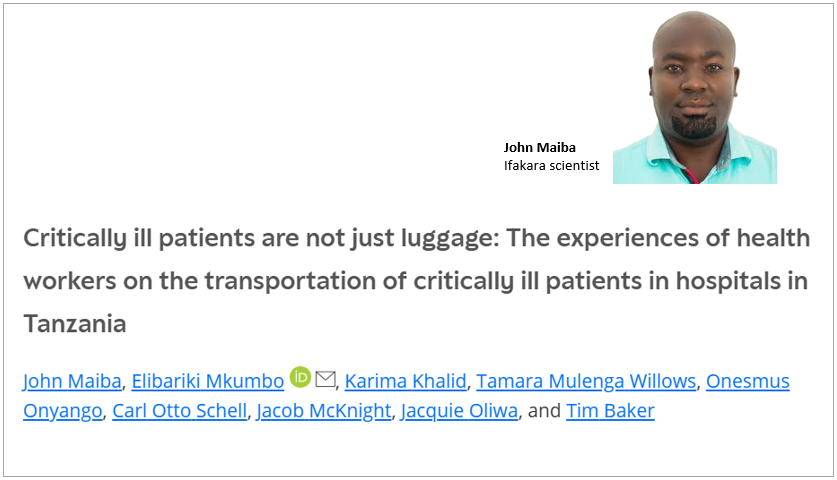
CARE: Making transfers safer for critically ill patients in Tanzania

Critically ill patients in Tanzanian hospitals face serious, yet often overlooked, risks during transfers within hospital grounds, a new study has revealed. According to the findings, poor infrastructure, limited resources, and weak procedures are putting lives in danger during what should be routine movements between hospital wards or departments.
The research, led by the Ifakara Health Institute (IHI) with co-authors John Maiba and Elibariki Mkumbo, was conducted in collaboration with experts from the University of Oxford (UK), the KEMRI–Wellcome Trust Research Programme (Kenya), and the Karolinska Institute (Sweden). The study was published on Journal of Health Services Research & Policy, in late September 2025.
Why it matters
Critical illness is a life-threatening condition that affects millions of patients across the world each year. For many of these patients, moving from one part of the hospital to another — for tests, surgery, or specialized care — is often necessary. Yet, this simple act of transportation can become a matter of life and death when hospitals lack the systems, equipment, or trained personnel needed to ensure safety.
In Tanzania, the study highlights that:
- Many hospitals lack reliable trolleys, stretchers, and elevators suitable for critical care transfers.
- Limited monitoring equipment and trained staff make it difficult to manage patients’ conditions during movement.
- Weak coordination and unclear procedures contribute to delays and medical errors.
An overlooked threat
The researchers warn that unsafe hospital transfers are a silent but significant contributor to avoidable deaths and poor patient outcomes. While much attention is paid to emergency care and intensive treatment, the moments in between — such as when patients are moved — are often neglected.
“Every minute and every movement matter when a patient is critically ill,” the authors emphasize. They call for stronger hospital systems, training for health workers, and better infrastructure to make hospital transfers safer for all patients.
Neglected but critical process
Researchers interviewed 15 health workers from five hospitals across Tanzania to document their experiences. The study found that moving patients inside hospitals — known as intra-hospital transport — is a high-risk process that remains largely neglected.
“Critically ill patients are not just luggage,” one health worker told researchers, underlining the need for greater attention to patient safety during hospital transport.
The study identified three major challenges affecting patient transport:
- Hospital design and organization often make it difficult to move patients quickly and safely.
- Shortages of essential equipment such as monitoring devices and oxygen increase the risk of deterioration during transfers.
- Poor communication and coordination between departments lead to unsafe handovers and confusion about patient care.
“Overall, we found that the transport of critically ill patients was overlooked in hospital services,” noted the researchers. “Health workers’ experiences were overwhelmingly focused on challenges rather than good practices.”
Simple solutions needed to save lives
While the findings expose serious gaps, the study emphasizes that improving patient transport does not require expensive technology. Instead, small, low-cost measures can make a big difference on patient safety.
These include:
- Establishing clear transport protocols and routines
- Improving communication systems and handover processes
- Streamlining transport routes that are clear and shorter
- Ensuring availability of essential supplies like to oxygen and monitoring equipment,
- Training staff to manage transport safely and efficiently
Aligning care with global standards
These improvements align with the global Essential Emergency and Critical Care (EECC) principles, which advocate for hospitals to provide consistent, basic life-saving care for critically ill patients — not only in intensive care units but throughout their stay in the hospital, including during transportation.
The study concludes that the safe transport of critically ill patients remains a crucial yet often overlooked aspect of hospital care in Tanzania. It further underscores the need for “feasible solutions to address existing challenges and reduce the high rates of mortality and morbidity among critically ill patients.”
Read more here.
